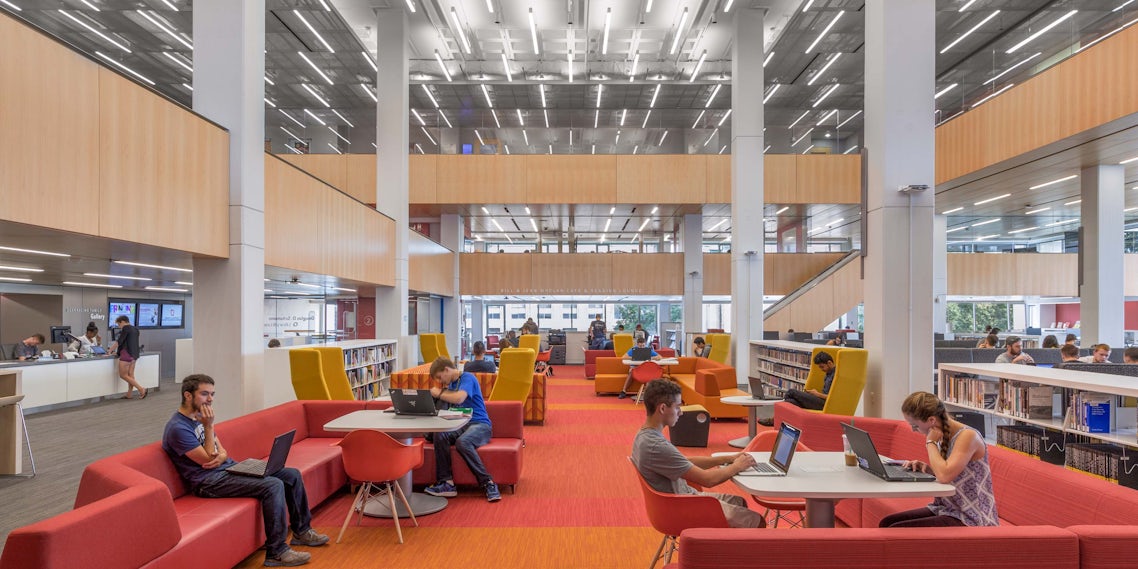In line with our new content direction, Architizer is highlighting a different building-product and how to specify it. This week’s topic is Acoustic Panels. If you’re looking for the perfect acoustic panels for your next project, search for them on Source, Architizer’s new network marketplace for building-products. Click here to see if you qualify. It’s free for architects.
One small, mighty and incredibly innovative brand that’s taking the world of acoustic design by storm is Navy Island. A family-owned business born in West St. Paul, Minnesota, their revolutionary micro-perforated acoustic panels have been used in major modern interior constructions such as One World Observatory, the Clark Art Institute, the U.S. Air Force Academy in Colorado Springs and J.W. Marriott hotels.
Their patented product, SoundPly, is making it easier for architects to choose a versatile interior cladding material that can completely disguise its acoustic function without sacrificing a sleek look. SoundPly is thin and works as a virtually seamless wooden backdrop that diminishes sound in any room.

Left: exploded diagram of a SoundPly panel, which is composed of several layers including the micro-perforated skin, a proprietary polymer, a core material (either glass wool, rock wool or wood fiber) and a back panel of secondary polymer; right: Douglas D. Schumann Library & Learning Commons at the Wentworth Institute of Technology
The physics behind this is game-changing. Like any acoustical product, veneer panels have the power to absorb and attenuate sound at high levels depending on their shape and application. That alone is powerful. But SoundPly, initially developed five years ago, offers two different types of sound absorption in one — both porous and resonate. This key combination is why Navy Island boasts SoundPly as the world’s quietest acoustics panels with their thickness.

Understanding the impact various treatments have on a physical space is vital to specifying an acoustic product. Choosing the right materials can make or break the way users interact with and, eventually, fall in love with being inside a building. Poor sound yields poor architecture. It’s basic science. That’s why SoundPly’s panels are different than any other acoustic panel on the market. Usually designed with an MDF or particleboard core, other micro-perforated panels have a less than 34 percent functional area because their manufactured cores obstruct the perforations that help compress air and minimize reflected sound.

Chart comparing the performance quality of SoundPly to other acoustic panel manufacturers
SoundPly’s panels are fully functional and feature perforations with a tested ideal diameter of 0.45 to 0.55 millimeters at a depth of 1.8 to 2.1 millimeters spaced 2.5 millimeters apart. Standard micro-perforations are usually 0.60 millimeters or smaller. SoundPly’s signature broach pin punch creates sharp holes without craters that effectively allow sound to pierce through the panels and create the most comprehensive noise reduction compression rating (NRC). The diameter, depth, spacing and cavity depth behind these micro-perforations end up controlling the resonant properties of the panel, which, again, are what make SoundPly stand out from its competitors.


Video showing a 2,000-hertz
“Resonant panels are the only kind of panel that uses sound against itself,” Navy Island’s CEO Jeff Stone said. “They’re like a little turbocharger that uses waste from the engine to create another by-product. There’s more air to fuel the engine for better performance.”
The by-product created from the SoundPly panels actually is oppressed sound. The micro-perforations compress the air and subtly reflect the energy away from the surface before friction occurs between the boundary layer of air molecules. This friction converts the compressed molecule’s energy into surface heat, which dissipates into the surface and surrounding air. This imperceptible science is what makes the product so powerful.

Perforated cross section unveiling the diameter between the micro-perforations
One of the biggest reasons SoundPly is being specified by major firms around the country — not to mention a few top-tier tech brands in California — is because it’s as aesthetically pleasing as it is inventive in function. When it comes to wooden acoustics, these products are usually part of an acoustic system with a pass-through panel that absorbs the sound. SoundPly is a singular hard-surface product that doesn’t require exposing the wall or incorporating a back-loaded material whose properties can’t be controlled.
“Architects and designers are becoming hyper sensitive to formaldehyde-containing products,” Stone said. “It’s not often brought up because there aren’t many good solutions out there, but I would really caution architects not to use pass-through panels that use uncontrolled products that are added behind the panel and open up the interior. It’s important to keep that envelope sealed.”

Left: the Clark Art Institute in Williamstown, Mass.; right: Vagelos Education Center at Columbia University
SoundPly isn’t solely applicable to walls. It’s available as ceiling panels, baffles, clouds, furniture components, planks and movable partitions. Navy Island also offers a massive gallery of molds and veneer options for the product with over 714 wood species, slices and grade choices. What’s more is that SoundPly is the only panel offered in the country that can be blueprint-matched with non-acoustic panels.

Left: One World Observatory at 1 World Trade Center; right: U.S. Air Force Academy
There is a handful of manufacturers around the world that produce micro-perforated acoustic panels. Depending on what type of installation as well as attentuation you’re looking for, SoundPly might be one of the best choices in terms of sheer simplicity of its product. As Navy Island continues to reinvent the wheel when it comes to acoustics, it’s important for architects to consider the ways in which a product like this can not only be more cost-effective for a project, but can technically and aesthetically perform well and enhance a room. Sound may be an invisible sense, but it plays a big role in the health and successful use of any piece of architecture.
Images courtesy Navy Island
To find the right acoustic panels for your next project, search on Source, Architizer’s new community marketplace for building-products. Click here to sign up now.




